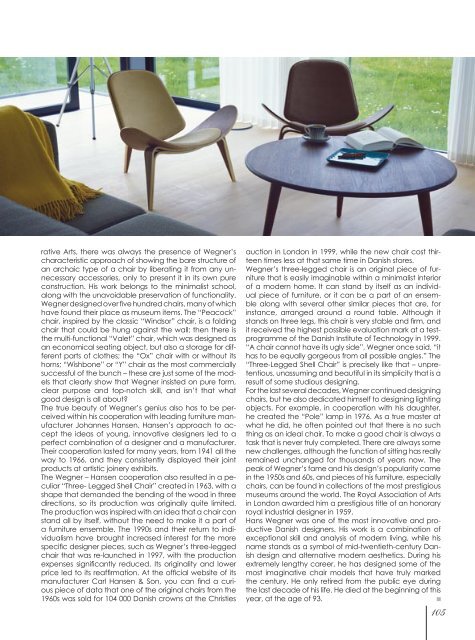ROBERT SEVER CELEBRITYJI - DalCasa
ROBERT SEVER CELEBRITYJI - DalCasa
ROBERT SEVER CELEBRITYJI - DalCasa
You also want an ePaper? Increase the reach of your titles
YUMPU automatically turns print PDFs into web optimized ePapers that Google loves.
ative Arts, there was always the presence of Wegner’s<br />
characteristic approach of showing the bare structure of<br />
an archaic type of a chair by liberating it from any unnecessary<br />
accessories, only to present it in its own pure<br />
construction. His work belongs to the minimalist school,<br />
along with the unavoidable preservation of functionality.<br />
Wegner designed over five hundred chairs, many of which<br />
have found their place as museum items. The “Peacock”<br />
chair, inspired by the classic “Windsor” chair, is a folding<br />
chair that could be hung against the wall; then there is<br />
the multi-functional “Valet” chair, which was designed as<br />
an economical seating object, but also a storage for different<br />
parts of clothes; the “Ox” chair with or without its<br />
horns; “Wishbone” or “Y” chair as the most commercially<br />
successful of the bunch – these are just some of the models<br />
that clearly show that Wegner insisted on pure form,<br />
clear purpose and top-notch skill, and isn’t that what<br />
good design is all about?<br />
The true beauty of Wegner’s genius also has to be perceived<br />
within his cooperation with leading furniture manufacturer<br />
Johannes Hansen. Hansen’s approach to accept<br />
the ideas of young, innovative designers led to a<br />
perfect combination of a designer and a manufacturer.<br />
Their cooperation lasted for many years, from 1941 all the<br />
way to 1966, and they consistently displayed their joint<br />
products at artistic joinery exhibits.<br />
The Wegner – Hansen cooperation also resulted in a peculiar<br />
“Three- Legged Shell Chair” created in 1963, with a<br />
shape that demanded the bending of the wood in three<br />
directions, so its production was originally quite limited.<br />
The production was inspired with an idea that a chair can<br />
stand all by itself, without the need to make it a part of<br />
a furniture ensemble. The 1990s and their return to individualism<br />
have brought increased interest for the more<br />
specific designer pieces, such as Wegner’s three-legged<br />
chair that was re-launched in 1997, with the production<br />
expenses significantly reduced. Its originality and lower<br />
price led to its reaffirmation. At the official website of its<br />
manufacturer Carl Hansen & Son, you can find a curious<br />
piece of data that one of the original chairs from the<br />
1960s was sold for 104 000 Danish crowns at the Christies<br />
auction in London in 1999, while the new chair cost thirteen<br />
times less at that same time in Danish stores.<br />
Wegner’s three-legged chair is an original piece of furniture<br />
that is easily imaginable within a minimalist interior<br />
of a modern home. It can stand by itself as an individual<br />
piece of furniture, or it can be a part of an ensemble<br />
along with several other similar pieces that are, for<br />
instance, arranged around a round table. Although it<br />
stands on three legs, this chair is very stable and firm, and<br />
it received the highest possible evaluation mark at a testprogramme<br />
of the Danish Institute of Technology in 1999.<br />
“A chair cannot have its ugly side”, Wegner once said, “it<br />
has to be equally gorgeous from all possible angles.” The<br />
“Three-Legged Shell Chair” is precisely like that – unpretentious,<br />
unassuming and beautiful in its simplicity that is a<br />
result of some studious designing.<br />
For the last several decades, Wegner continued designing<br />
chairs, but he also dedicated himself to designing lighting<br />
objects. For example, in cooperation with his daughter,<br />
he created the “Pole” lamp in 1976. As a true master at<br />
what he did, he often pointed out that there is no such<br />
thing as an ideal chair. To make a good chair is always a<br />
task that is never truly completed. There are always some<br />
new challenges, although the function of sitting has really<br />
remained unchanged for thousands of years now. The<br />
peak of Wegner’s fame and his design’s popularity came<br />
in the 1950s and 60s, and pieces of his furniture, especially<br />
chairs, can be found in collections of the most prestigious<br />
museums around the world. The Royal Association of Arts<br />
in London awarded him a prestigious title of an honorary<br />
royal industrial designer in 1959.<br />
Hans Wegner was one of the most innovative and productive<br />
Danish designers. His work is a combination of<br />
exceptional skill and analysis of modern living, while his<br />
name stands as a symbol of mid-twentieth-century Danish<br />
design and alternative modern aesthetics. During his<br />
extremely lengthy career, he has designed some of the<br />
most imaginative chair models that have truly marked<br />
the century. He only retired from the public eye during<br />
the last decade of his life. He died at the beginning of this<br />
year, at the age of 93.<br />
105

















